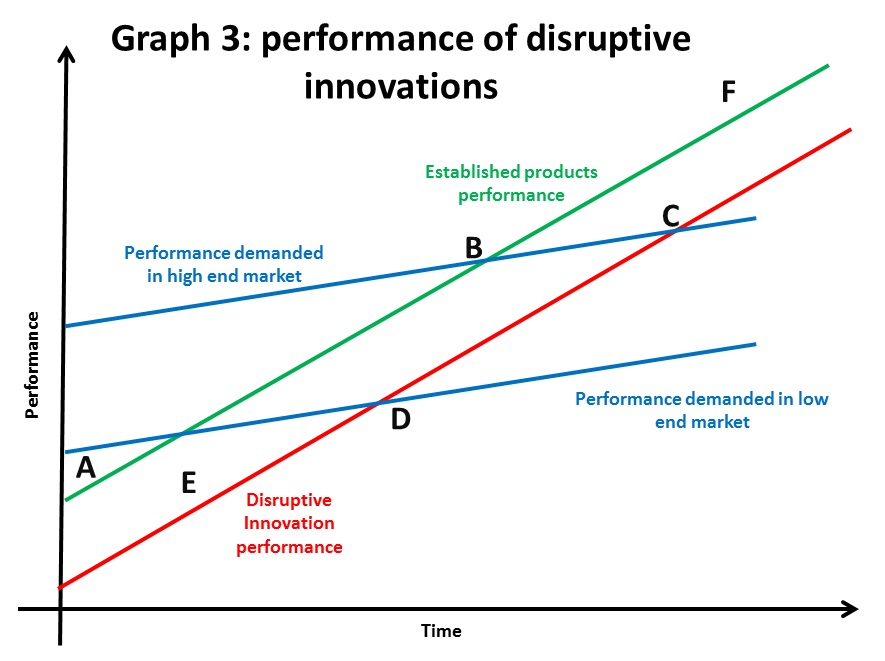Anticipating disruptive innovation is critical to any business. Today, disruptive innovation explains why:
- Salesforce.com, with its simple, internet-based system, is disrupting the leading providers of customer relationship management software such as Siebel systems
- Seiko watches disrupted Swiss watch manufacturers
- Coursera, with its online educational programs, is disrupting four-year colleges
Today, I want to show how disruptive innovation goes about killing established companies.
As indicated previously, any market is determined by:
- a performance criteria
- performance demanded in high end markets and low end markets. This performance improves over time
- established product performance
What’s striking is that, in many industries, including, Disk Drives, Automobiles, Education, Software, Steel, Computers, Retail and many more, established product performance improves at a faster rate than market demands. Thus, in time, established companies develop products that overshoot what the market needs. And this creates a vacuum at the low end of the market for a disruptive innovation.
Today, I want to provide more details on how disruptive innovation occurs. To do, I’ll be using the graph below:
Comments on graph 3 helps at anticipating disruptive innovation
There’s only one difference between graph 2 and graph 3 and that is the red line, representing disruptive innovation.
What’s remarkable is that disruptive innovation boast lower performance than established products. For example, today, the electric car, widely considered to be a disruptive innovation, is typically slower and less autonomous than gasoline powered cars.
So I guess that the most obvious question is: who would ever buy it? This is critically important question. If no market is found, than disruptive innovation will die out. So the first challenge in managing a disruptive innovation is finding the right market; finding a market that accepts the disruptive innovation’s limitations. In any case, who would ever buy a car that is more expensive and, at the same time, less performance competitive than existing gasoline powered cars?
Maybe, cautious parents would be interested in buying a slower car for their growing kids. After all, they may worry that their kids, new to driving, maybe driving too fast, too soon, sometimes, at the cost of their life. They may be interested in buying a slower car; they may also like the fact that the electric is less autonomous than gasoline cars. This could serve as a guarantee that their kids won’t driving out too far.
Similarly, when solid-state drives first came out, they were an under-performing disruptive technology. They could be as much as fifty times more expense and would offer lower memory capacity. However, they offer other advantages, such as:
- ruggedness, given that they have no moving parts
- lower energy consumption
Anybody working in IT would want to improve solid-state drives, in terms of capacity and costs before including them into new mainstream portable computers, which they would sell to mainstream consumers, like you and me. But, again, that would be a mistake: nobody would ever be willing to buy a more expensive computer that offers less memory capacity. So again, selling disruptive technology to your existing customers in existing markets, is not the right way to go about it.
The key to developing disruptive innovation is finding a market that accepts the technology as it is. As solid-state drive inventors were looking for a new market that would value what their technology could offer (high price, low memory capacity, low energy consumption and high ruggedness), they ended finding a market that was very distant from computers. It was, according to Clayton Christensen, heart monitory devices and cell phones.
In other words the key to harnessing a disruptive innovation is finding a new market for what seems to be an under-performing product. This is very different from what established companies tend to do. Captive of their large customers, they try to improve the disruptive innovation so that it meets performance criteria demanded by their existing clients, in existing markets. In fact, they should try to identify new markets and new clients in which they could incorporate the technology as it is today, with its limitations.
Assuming that a market has been found, the disruptive technology will be improving year over year. At one point, the disruptive innovation performance will intersect with performance demanded in low end markets. Low end mainstream customers will then be able to choose between a gasoline car and electric car, both equally performance competitive, in terms of speed, autonomy and more. Mainstream customers will be quick to notice that the electric car offers features that the gasoline car doesn’t such as lower pollution and silence when driving. That’s when mainstream customers will choose the electric car over the gasoline car. And that’s how established products get wiped out of low-end markets. The same thing happens in high end markets as well.
Have you seen other instances where disruptive innovation is killing established companies? How has it happened? What have you learned?
Further readings on anticipating disruptive innovation
- For a discussion on how disruptive technology has transformed a fast-paced industry such as disk drives, please refer to Clayton Christensen’s Innovator’s Dilemma, chapter 1; for a discussion on how disruptive innovation has transformed slow-paced industries, please refer to chapter 3
- For a discussion on how disruptive innovation really changes industry structure, please refer to Clayton Christensen’s Innovator’s Prescription, chapter 8
- For a discussion on how the definition of performance in an industry is a function of disruptive innovation, please refer to Clayton Christensen’s Innovator’s Dilemma, chapter 11
- For a discussion of why established companies fail at disruptive innovation, please refer to Clayton Christensen’s Innovator’s Solution, chapter 1

[…] For other examples of how disruptive innovation may undermine business models, please refer here […]
[…] How does disruptive innovation go about toppling established companies? Is there a pattern to disruptive innovation, allowing for better anticipation? […]
[…] Pour une autre analyse sur la disruption des acteurs du cloud par rapport aux entreprises établies, veuillez vous référer à cet article […]